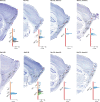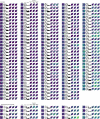Toroidal topology of population activity in grid cells
- PMID: 35022611
- PMCID: PMC8810387
- DOI: 10.1038/s41586-021-04268-7
Toroidal topology of population activity in grid cells
Abstract
The medial entorhinal cortex is part of a neural system for mapping the position of an individual within a physical environment1. Grid cells, a key component of this system, fire in a characteristic hexagonal pattern of locations2, and are organized in modules3 that collectively form a population code for the animal's allocentric position1. The invariance of the correlation structure of this population code across environments4,5 and behavioural states6,7, independent of specific sensory inputs, has pointed to intrinsic, recurrently connected continuous attractor networks (CANs) as a possible substrate of the grid pattern1,8-11. However, whether grid cell networks show continuous attractor dynamics, and how they interface with inputs from the environment, has remained unclear owing to the small samples of cells obtained so far. Here, using simultaneous recordings from many hundreds of grid cells and subsequent topological data analysis, we show that the joint activity of grid cells from an individual module resides on a toroidal manifold, as expected in a two-dimensional CAN. Positions on the torus correspond to positions of the moving animal in the environment. Individual cells are preferentially active at singular positions on the torus. Their positions are maintained between environments and from wakefulness to sleep, as predicted by CAN models for grid cells but not by alternative feedforward models12. This demonstration of network dynamics on a toroidal manifold provides a population-level visualization of CAN dynamics in grid cells.
© 2022. The Author(s).
Conflict of interest statement
The authors declare no competing interests.
Figures














References
-
- McNaughton BL, Battaglia FP, Jensen O, Moser EI, Moser M-B. Path integration and the neural basis of the ‘cognitive map’. Nat. Rev. Neurosci. 2006;7:663–678. - PubMed
-
- Hafting T, Fyhn M, Molden S, Moser M-B, Moser EI. Microstructure of a spatial map in the entorhinal cortex. Nature. 2005;436:801–806. - PubMed
-
- Stensola H, et al. The entorhinal grid map is discretized. Nature. 2012;492:72–78. - PubMed
-
- Fyhn M, Hafting T, Treves A, Moser M-B, Moser EI. Hippocampal remapping and grid realignment in entorhinal cortex. Nature. 2007;446:190–194. - PubMed
Publication types
MeSH terms
Grants and funding
LinkOut - more resources
Full Text Sources

